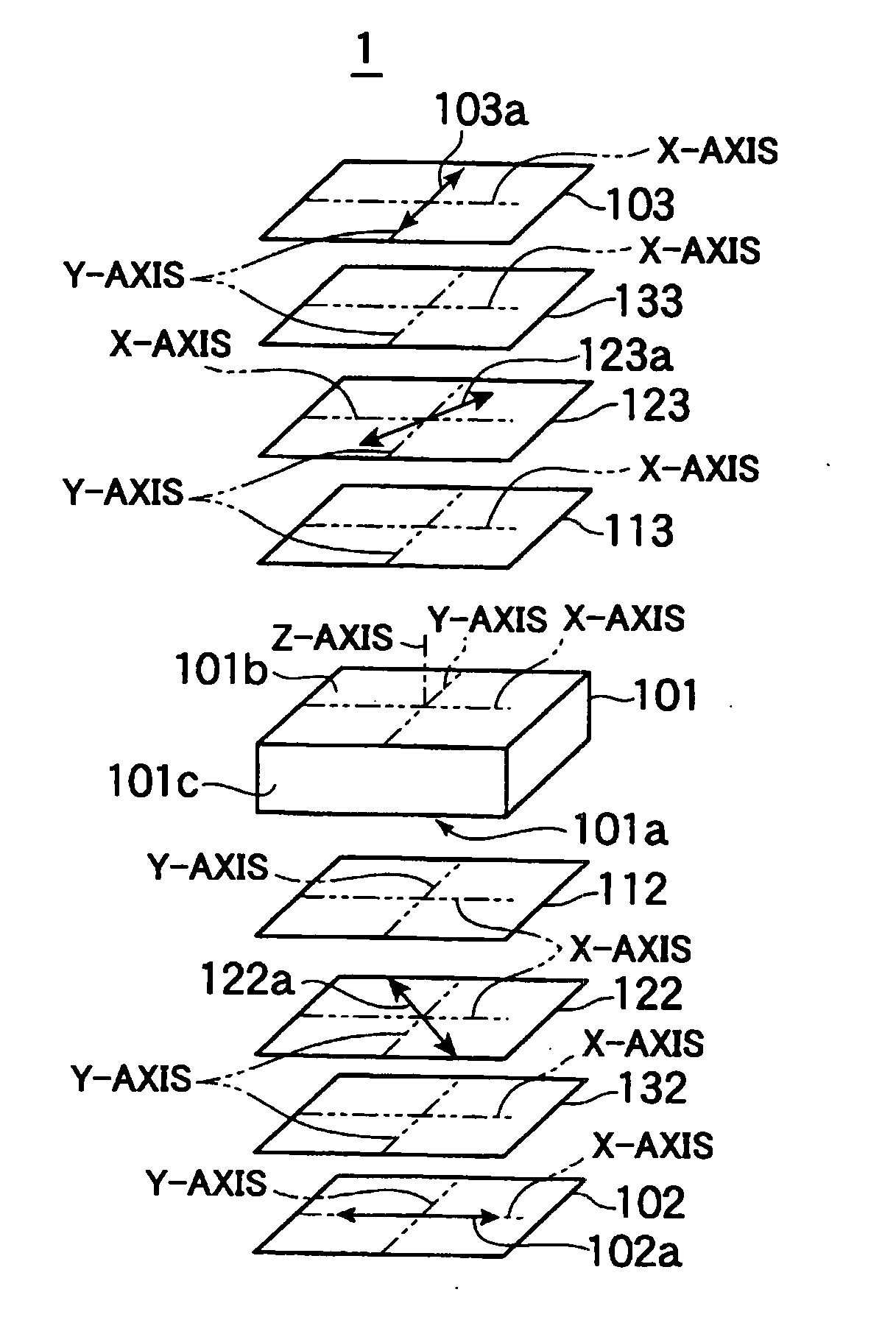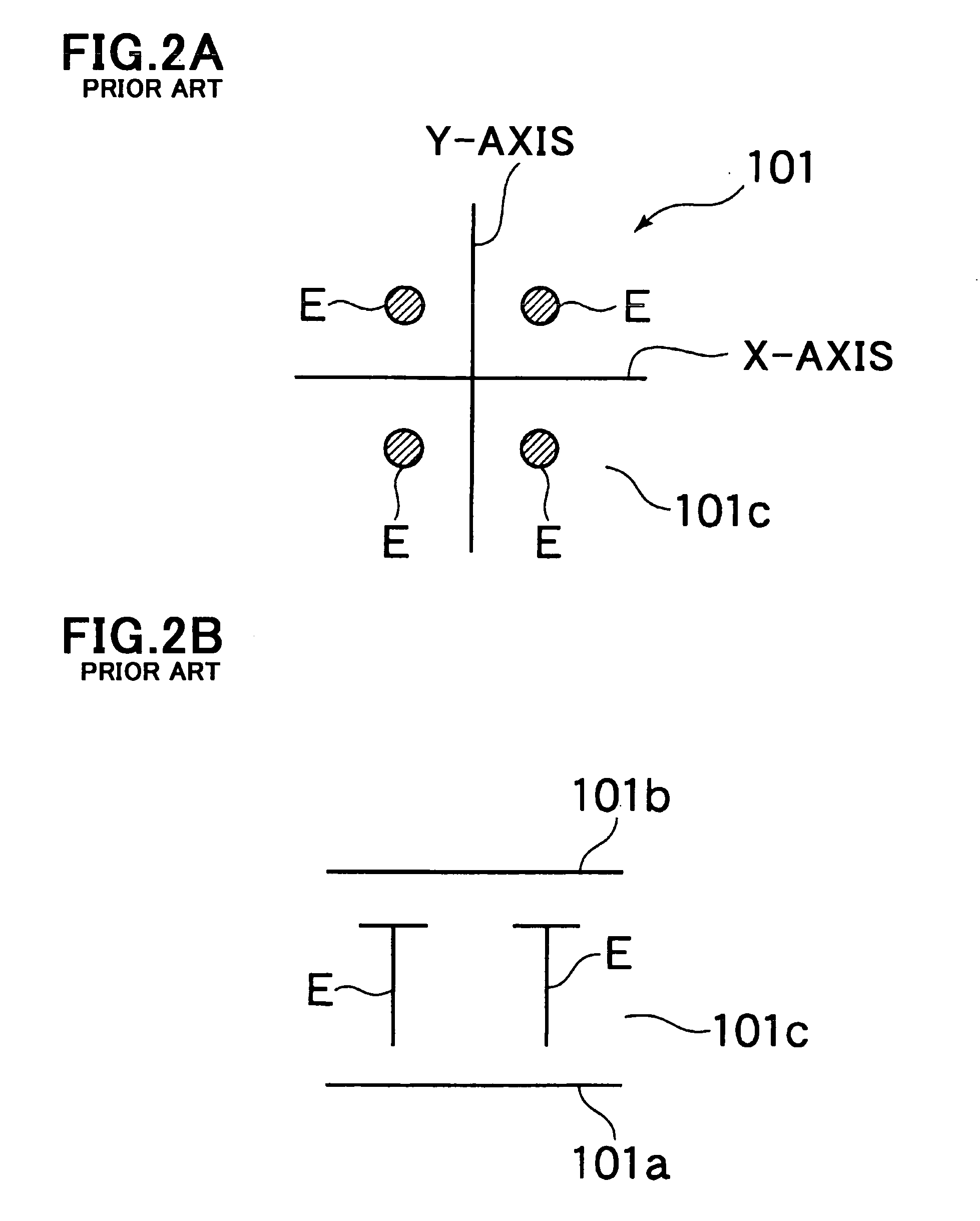Liquid crystal display device
a liquid crystal display and display device technology, applied in the direction of instruments, polarising elements, optics, etc., can solve the problems of poor symmetry, light leakage, and the inability to obtain the desired viewing angle characteristic,
- Summary
- Abstract
- Description
- Claims
- Application Information
AI Technical Summary
Benefits of technology
Problems solved by technology
Method used
Image
Examples
first embodiment
[0162]FIG. 20A is a front cross-sectional view illustrating a layered-structure of a liquid crystal display device 1 in accordance with the first embodiment of the present invention, and FIG. 20B is a broken perspective view of the liquid crystal display device 1.
[0163] As illustrated in FIG. 20A, the liquid crystal display device 1 is comprised of a liquid crystal cell 101 including vertically aligned liquid crystal, a first polarizer plate 102 arranged on one of surfaces of the liquid crystal cell 101, a second polarizer plate 103 arranged on the other surface of the liquid crystal cell 101, a first λ / 4 plate 122 arranged between the liquid crystal cell 101 and the first polarizer plate 102, a second λ / 4 plate 123 arranged between the liquid crystal cell 101 and the second polarizer plate 103, a first optical compensation layer 112 arranged between the liquid crystal cell 101 and the first λ / 4 plate 122, and having negative uniaxial retardation, a second optical compensation laye...
second embodiment
[0233]FIG. 40A is a front cross-sectional view of a liquid crystal display device 10 in accordance with the second embodiment of the present invention, and FIG. 40B is a broken perspective view of the liquid crystal display device 10.
[0234] As illustrated in FIG. 40A, the liquid crystal display device 10 in accordance with the second embodiment is designed not to include the second optical compensation layer 113 in comparison with the liquid crystal display device 1 illustrated in FIGS. 20A and 20B. The liquid crystal display device 10 in accordance with the second embodiment has the same structure as that of the liquid crystal display device 1 except in not including the second optical compensation layer 113.
[0235] The first and second polarizer-supports 132 and 133 in the second embodiment have retardation of 25 nanometers in a thickness-wise direction thereof.
[0236] The inventors tested viewing angle characteristic in six liquid crystal display devices each of which had the sa...
third embodiment
[0251] In the above-mentioned first and second embodiments, a liquid crystal cell allows a light to pass therethrough. In the third embodiment explained hereinbelow, a liquid crystal cell has a pixel electrode both having a first area in which a light is allowed to pass therethrough, and a second area in which a light is reflected.
[0252]FIG. 53 is a perspective view of a liquid crystal cell 53 in a liquid crystal display device in accordance with the third embodiment, and FIG. 54 is a plan view of the liquid crystal cell 53. For simplification, general parts constituting a liquid crystal display device, such as a thin film transistor (TFT) and a wiring electrode, are omitted in FIGS. 53 and 54.
[0253] As illustrated in FIGS. 53 and 54, the liquid crystal cell 53 is of so-called half-transmission type, that is, the liquid crystal cell 53 has a pixel electrode 101e comprised of a transparent electrode 532 in which a light is allowed to pass therethrough, and a light-reflection electr...
PUM
 Login to View More
Login to View More Abstract
Description
Claims
Application Information
 Login to View More
Login to View More - R&D
- Intellectual Property
- Life Sciences
- Materials
- Tech Scout
- Unparalleled Data Quality
- Higher Quality Content
- 60% Fewer Hallucinations
Browse by: Latest US Patents, China's latest patents, Technical Efficacy Thesaurus, Application Domain, Technology Topic, Popular Technical Reports.
© 2025 PatSnap. All rights reserved.Legal|Privacy policy|Modern Slavery Act Transparency Statement|Sitemap|About US| Contact US: help@patsnap.com



